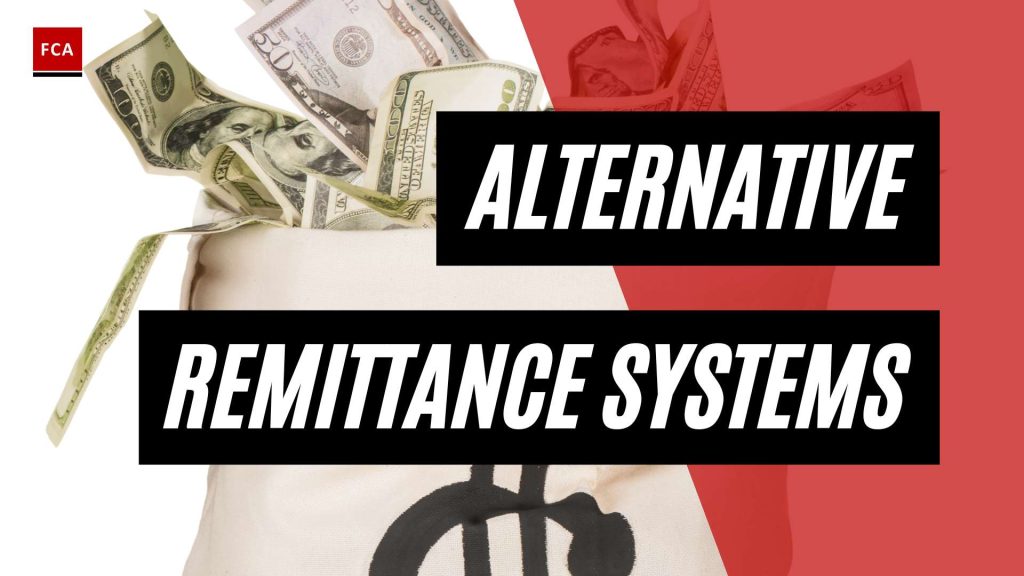Alternative Remittance Systems: An Overview
Alternative remittance systems have gained significant attention due to their potential involvement in money laundering and terrorism financing activities, posing risks to global financial systems and security (NCJRS Virtual Library). These systems provide an informal mechanism for transferring funds outside of traditional banking systems, often bypassing regulatory scrutiny.
Understanding Alternative Remittance Systems
Alternative remittance systems refer to non-bank channels and methods used for transferring funds. These systems operate outside of traditional banking systems, relying on various informal mechanisms to facilitate money transfers. One well-known example of an alternative remittance system is Hawala, which originated in South Asia and the Middle East and dates back to the 8th century (Investopedia). Hawala operates on the basis of trust and extensive networks of brokers to facilitate money transfers without physically moving the funds across borders.
Risks and Challenges in Regulating Alternative Remittance Systems
Regulating alternative remittance systems poses significant challenges due to their cross-border nature and informal characteristics. These systems often operate outside of traditional regulatory frameworks, making enforcement and compliance difficult for authorities (NCJRS Virtual Library). The lack of transparency and regulatory oversight in alternative remittance systems creates opportunities for illicit financial activities, as they can be exploited by criminals and terrorist groups to transfer funds covertly (NCJRS Virtual Library).
To address the risks associated with alternative remittance systems, regulatory efforts are being made to strengthen oversight and regulation. Authorities are working towards establishing frameworks that enhance transparency, monitor transactions, and ensure compliance with anti-money laundering and counter-terrorism financing measures. International cooperation plays a crucial role in addressing alternative remittance systems, as these systems often involve cross-border transactions (NCJRS Virtual Library).
Understanding the vulnerabilities and risks associated with alternative remittance systems is vital for implementing effective regulatory frameworks and enforcement strategies. By addressing these challenges, authorities can mitigate the risks of money laundering and terrorism financing activities, safeguarding the integrity of financial systems (NextGen Money).
Hawala: The Informal Value Transfer System
Hawala is a well-known example of an informal value transfer system that operates outside of traditional banking systems. It is characterized by its reliance on trust and extensive networks of brokers. Hawala has its origins in Islamic communities and has been used for centuries as a means of transferring funds across borders with minimal documentation.
Origins and Functioning of Hawala
The traditional hawala system, with its roots in the Middle East, has a rich history dating back to ancient times. It emerged as a way for traders to transfer money across long distances without the need for physical transportation. Today, hawala networks can be found in various regions around the world.
In the hawala system, individuals known as hawala brokers act as intermediaries between the sender and recipient of funds. The sender provides cash to a local hawala broker, who then contacts a corresponding hawala broker in the recipient’s location. The recipient can then collect the funds from their local hawala broker, often in the form of cash.
What sets hawala apart is its reliance on trust and reputation within the network. Rather than relying on formal contracts or legal agreements, hawala transactions are based on the personal relationships and integrity of the brokers involved. This system allows for fast and efficient transfers, often with lower fees compared to traditional banking channels.
Hawala as a Channel for Money Laundering and Terrorism Financing
While hawala serves as a legitimate means of transferring funds for many individuals and businesses, its informal nature and lack of regulatory oversight make it vulnerable to abuse. Terrorist organizations, such as Al-Qaeda, have been known to exploit alternative remittance systems like hawala for moving funds across borders due to the anonymity they provide (NextGen Money).
The lack of transparency and regulatory oversight in hawala and other alternative remittance systems makes them attractive for illicit activities, including money laundering and terrorism financing. The absence of proper documentation and reporting requirements makes it difficult for authorities to track and monitor the movement of funds.
To address these risks, international efforts have been made to enhance the regulation and oversight of alternative remittance systems, including hawala. Authorities have implemented measures to strengthen anti-money laundering and counter-terrorism financing frameworks, aiming to detect and prevent illicit financial flows. Cooperation between countries and information sharing among financial intelligence units play a crucial role in combating the misuse of alternative remittance systems.
Understanding the functioning of hawala and other informal value transfer systems is essential for financial institutions, compliance professionals, and law enforcement agencies who seek to mitigate the risks associated with money laundering and terrorism financing. By adopting effective regulatory measures and promoting transparency, the balance between security and financial inclusion can be achieved, ensuring the integrity of the global financial system.
Other Informal Value Transfer Systems
While hawala is one of the most well-known alternative remittance systems, there are other informal value transfer systems that exist alongside it. These systems, including hundi and others, operate outside of traditional banking channels and offer alternative avenues for transferring funds. However, like hawala, they also pose risks and vulnerabilities in terms of financial transparency and regulatory oversight.
Hundi and Other Alternative Remittance Systems
Hundi is an informal value transfer system that originated in South Asia and is still prevalent today. It operates on principles similar to hawala, relying on trusted intermediaries to facilitate transactions (Investopedia). In a hundi transaction, a person seeking to send money provides funds to a hundi broker. The broker then provides a code or a written note to the recipient, who can then present it to another hundi broker to receive the funds. This system operates on trust and social connections, forging networks that enable the transfer of money without physically moving it across borders.
Apart from hundi, there are various other alternative remittance systems that differ based on cultural, regional, or historical contexts. These systems often rely on close-knit communities or networks of trust to facilitate transactions. Examples include the Chinese underground banking system known as fei ch’ien and other localized systems that have emerged in different parts of the world.
Risks and Vulnerabilities of Informal Value Transfer Systems
The use of alternative remittance systems, including hawala, hundi, and other informal value transfer systems, presents risks and vulnerabilities in terms of financial transparency and regulatory oversight. The lack of a formalized structure and regulatory framework makes it easier for these systems to be exploited for illicit activities such as money laundering and terrorist financing. Criminals and terrorist organizations may leverage the anonymity and lack of oversight to transfer funds covertly, bypassing traditional banking systems and scrutiny.
The vulnerabilities in these systems arise from factors such as the reliance on trust, the absence of proper documentation, and the limited or non-existent audit trails. The lack of transparency and regulatory oversight makes it challenging for authorities to track and monitor transactions effectively. This poses significant challenges for law enforcement agencies and regulatory bodies in their efforts to combat financial crimes.
Understanding the risks and vulnerabilities associated with alternative remittance systems is crucial for implementing effective regulatory frameworks and enforcement strategies. Regulatory authorities across the globe are taking steps to strengthen oversight and regulations to combat illicit activities and protect the integrity of financial systems. International cooperation and information sharing among regulatory bodies play a vital role in addressing the challenges posed by alternative remittance systems.
By addressing the risks and vulnerabilities, regulatory authorities can strike a balance between security and financial inclusion. This involves implementing measures to ensure transparency in alternative remittance systems while mitigating the risks associated with money laundering and terrorist financing activities. Such efforts aim to safeguard the integrity of the financial system while allowing individuals and communities to access remittance services that meet their specific needs.
Regulatory Efforts and Countermeasures
In order to address the risks associated with alternative remittance systems, regulatory authorities have been actively working to strengthen oversight and regulation. Recognizing the challenges posed by these systems, efforts are being made to mitigate the vulnerabilities they present in terms of money laundering and terrorism financing.
Strengthening Oversight and Regulation
The informal and cross-border nature of alternative remittance systems creates regulatory challenges, making enforcement and compliance difficult for authorities (NCJRS Virtual Library). However, recognizing the need to mitigate the risks involved, regulatory bodies are implementing measures to enhance oversight and regulation.
One approach is to establish comprehensive regulatory frameworks that encompass alternative remittance systems. These frameworks outline the obligations and responsibilities of both the providers and users of these systems. By clearly defining the regulatory requirements, authorities can ensure that these systems operate in a transparent and accountable manner.
Regulators are also focusing on enhancing customer due diligence measures for alternative remittance systems. This includes implementing know-your-customer (KYC) procedures to verify the identities of individuals involved in transactions. Strengthening customer identification processes helps prevent the misuse of these systems for illicit activities.
Furthermore, increased reporting requirements have been put in place to improve transparency and enable authorities to monitor transactions more effectively. Reporting obligations for alternative remittance service providers help identify suspicious activities and facilitate the reporting of transactions that may be linked to money laundering or terrorism financing.
International Cooperation in Addressing Alternative Remittance Systems
Given the global nature of alternative remittance systems, international cooperation is crucial in combating the risks associated with these systems. Regulatory bodies, law enforcement agencies, and financial institutions across jurisdictions are collaborating to share information and best practices.
International organizations, such as the Financial Action Task Force (FATF), play a pivotal role in promoting cooperation and setting global standards for combating money laundering and terrorism financing. FATF recommendations provide guidance to countries in developing regulatory frameworks and implementing effective measures to address the risks posed by alternative remittance systems.
Bilateral and multilateral agreements between countries are also being established to facilitate information exchange and cooperation in investigations related to alternative remittance systems. Sharing intelligence and collaborating on enforcement actions enable authorities to uncover illicit activities and disrupt illicit financial flows.
To effectively address the risks associated with alternative remittance systems, ongoing collaboration and coordination among national and international stakeholders are essential. By working together, regulatory bodies can enhance oversight mechanisms and develop effective strategies to combat money laundering and terrorism financing activities facilitated through these systems.
Understanding the vulnerabilities and risks associated with alternative remittance systems is crucial for the development and implementation of robust regulatory frameworks. Regulatory authorities must continue to adapt to the evolving landscape of these systems and remain vigilant in their efforts to ensure the integrity of the financial system.
Balancing Security and Financial Inclusion
Alternative remittance systems play a significant role, particularly in low-income economies, where formal banking services may be limited or inaccessible. These systems provide a means for individuals to transfer funds across borders quickly, conveniently, and at a lower cost compared to traditional banking channels. However, striking a balance between security concerns and promoting financial inclusion is crucial in the context of alternative remittance systems.
The Role of Alternative Remittance Systems in Low-Income Economies
In countries with limited formal banking infrastructure, alternative remittance systems serve as a lifeline for individuals and communities, facilitating the flow of funds to support essential needs, such as education, healthcare, and basic living expenses. According to the Australian Institute of Criminology, billions of dollars are estimated to be transferred each year through informal channels by diaspora communities residing in countries like Australia, with total recorded remittances to developing countries reaching $529 billion in 2018.
For many individuals in low-income economies, alternative remittance systems offer a reliable and accessible method to receive funds from family members working abroad. These systems often operate within cultural and community networks, providing a sense of trust and security for both senders and recipients.
Ensuring Transparency and Mitigating Risks
While alternative remittance systems contribute to financial inclusion, they also pose risks in terms of money laundering and terrorism financing. The lack of regulation and oversight in these systems makes them vulnerable to exploitation by criminals, as highlighted by the Australian Institute of Criminology. It is estimated that the value of funds transferred through hawala networks alone could reach several hundred billion dollars annually.
To address these risks, it is crucial to enhance transparency within alternative remittance systems. Promoting record-keeping and documentation, even within informal financial networks, can help trace the source of funds and identify ultimate beneficiaries. Encouraging greater cooperation between financial intelligence units, law enforcement agencies, and international partners is essential to combat money laundering and terrorism financing facilitated through these systems.
Additionally, raising awareness among immigrant communities about the risks associated with unregulated remittance services is vital. Providing education and guidance on the benefits of using formal banking channels or licensed remittance providers can help individuals make informed decisions and protect themselves from potential exploitation.
By implementing effective strategies that enhance transparency, improve regulatory frameworks, and foster cooperation among relevant stakeholders, it is possible to strike a balance between security concerns and the promotion of financial inclusion. Such measures can help ensure that alternative remittance systems continue to serve as a valuable tool for individuals in low-income economies while mitigating the risks associated with illicit activities.
Investigating and Combating Illicit Activities
When it comes to combating illicit activities related to alternative remittance systems, law enforcement agencies face a range of challenges. These challenges arise due to the unique characteristics and complexities associated with these informal and cross-border systems. However, there are strategies that can be employed to address money laundering and terrorism financing effectively.
Challenges Faced by Law Enforcement Agencies
Law enforcement agencies encounter several challenges when investigating illicit activities connected to alternative remittance systems. Some of the key difficulties include:
-
Anonymity and Lack of Paper Trail: Alternative remittance systems, such as hawala and hundi, often operate outside of traditional banking systems and rely on trust and extensive networks of brokers. This lack of a paper trail makes it challenging for authorities to track money laundering, terrorism financing, and other illegal activities.
-
Cross-Border Transactions: Alternative remittance systems are typically used for cross-border transactions, making it difficult for law enforcement agencies to coordinate efforts across different jurisdictions. The absence of a centralized authority or regulatory framework further complicates investigations and enforcement actions.
-
Limited Reporting and Cooperation: Due to the informal nature of alternative remittance systems, individuals involved may be hesitant to report suspicious activities, making it challenging for law enforcement agencies to gather actionable intelligence. Additionally, cooperation from foreign jurisdictions may vary, hindering international efforts to combat illicit activities.
-
Technological Advancements: Criminals and illicit actors are adept at leveraging technology to exploit vulnerabilities in alternative remittance systems. The use of encryption, digital currencies, and online platforms further complicates the detection and investigation of illicit activities.
Strategies to Address Money Laundering and Terrorism Financing
To effectively address money laundering and terrorism financing associated with alternative remittance systems, law enforcement agencies employ various strategies:
-
Enhanced Collaboration and Information Sharing: Cooperation between domestic and international law enforcement agencies, financial intelligence units, and regulatory bodies is crucial. Sharing information, intelligence, and expertise can help identify patterns, trends, and individuals involved in illicit activities.
-
Targeted Investigations and Risk-Based Approaches: Law enforcement agencies prioritize investigations based on risk assessments and intelligence analysis. Focusing resources on high-risk individuals, networks, and regions can yield more significant results in combating money laundering and terrorism financing.
-
Technological Solutions and Data Analytics: Leveraging advanced technologies, such as data analytics and artificial intelligence, can assist in identifying suspicious patterns, transactions, and networks within alternative remittance systems. These tools can enhance the efficiency and effectiveness of investigations.
-
International Regulatory Frameworks: Collaborative efforts to establish international regulatory frameworks can facilitate the oversight and regulation of alternative remittance systems. Harmonizing regulations and standards can enhance transparency, deter illicit activities, and promote cooperation between jurisdictions.
-
Training and Capacity Building: Providing law enforcement agencies with specialized training on alternative remittance systems, financial investigations, and emerging trends is essential. Building the capacity of investigators and prosecutors can enhance their ability to detect, investigate, and prosecute cases related to money laundering and terrorism financing.
By addressing the challenges faced by law enforcement agencies and implementing targeted strategies, it is possible to mitigate the risks associated with alternative remittance systems. Continued collaboration, innovation, and international cooperation are key in the ongoing fight against illicit activities and the preservation of the integrity of financial systems.
Other Informal Value Transfer Systems
Hundi and Other Alternative Remittance Systems
Risks and Vulnerabilities of Informal Value Transfer Systems
In addition to hawala, there are other informal value transfer systems that operate as alternative remittance systems. One such system is the hundi system, which is prevalent in South Asia and the Middle East. Hundi is a traditional trust-based system that involves the transfer of funds through a network of intermediaries known as hundi brokers. These brokers facilitate the movement of funds between individuals without relying on formal banking channels. The hundi system operates on the basis of trust and relies heavily on personal connections and reputation.
Apart from hundi, there are various other alternative remittance systems that exist globally, such as fei ch’ien in China and other forms of underground banking in different regions. These systems often provide individuals with an alternative means of transferring funds, particularly in areas where formal banking infrastructure is limited or where individuals have limited access to traditional financial services.
While alternative remittance systems can serve as a lifeline for individuals in certain regions, they also pose significant risks and vulnerabilities. The lack of transparency and regulatory oversight in these systems makes them susceptible to exploitation for illicit financial activities, including money laundering and terrorism financing. Criminals and terrorist groups may take advantage of the informal nature of these systems to transfer funds covertly, bypassing traditional banking systems and scrutiny.
The risks associated with alternative remittance systems have been recognized globally, and regulatory efforts are being made to address these challenges. Authorities are working towards strengthening oversight and regulation of these systems to mitigate the risks they pose to financial systems and security. However, due to the cross-border and informal nature of these systems, enforcing regulations and ensuring compliance can be complex and challenging.
To effectively combat money laundering and terrorism financing activities facilitated through alternative remittance systems, international cooperation is crucial. Collaboration among regulatory authorities and financial institutions across borders is necessary to share information, intelligence, and best practices. This cooperation can enhance the effectiveness of regulatory efforts and help establish a more robust framework for combating illicit activities in the realm of alternative remittance systems.
By understanding the vulnerabilities and risks associated with alternative remittance systems, regulatory authorities can develop and implement effective frameworks for oversight and enforcement. Striking the right balance between security and financial inclusion is essential to ensure that individuals in low-income economies have access to legitimate financial services while minimizing the risks posed by illicit financial activities. Transparency and collaboration among stakeholders, including governments, financial institutions, and regulators, are key to achieving this balance.
The investigation and combating of illicit activities in alternative remittance systems present significant challenges for law enforcement agencies. The anonymous nature of transactions and the complexity of these systems make it difficult to trace and identify individuals involved in money laundering and terrorism financing. Law enforcement agencies need to employ robust strategies, including intelligence gathering, international cooperation, and the use of advanced financial investigative tools, to effectively address these challenges.
By staying vigilant, implementing comprehensive regulatory frameworks, and leveraging international collaboration, authorities can combat the risks associated with alternative remittance systems. These efforts are crucial to safeguarding the integrity of financial systems and protecting against the misuse of these systems for illicit purposes.








